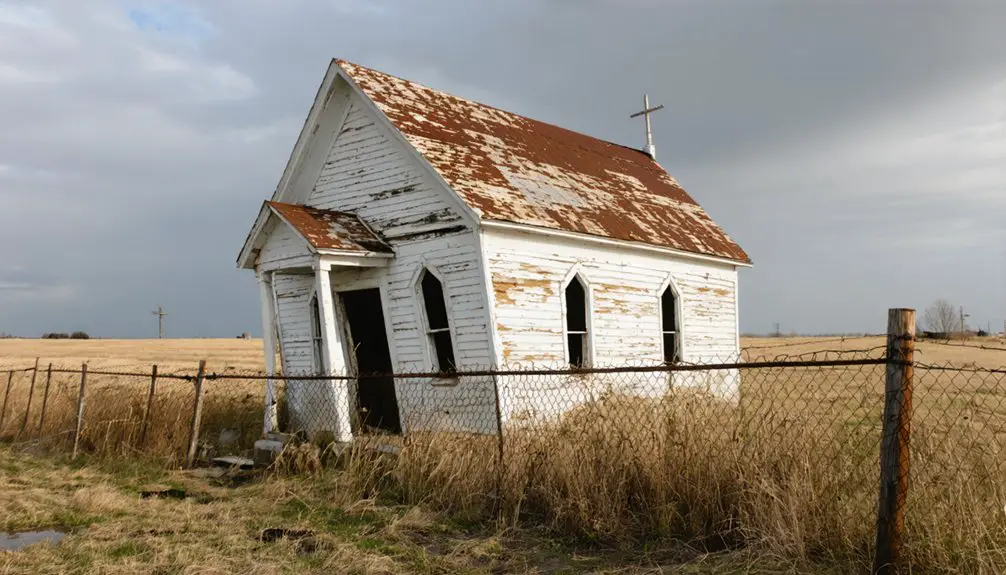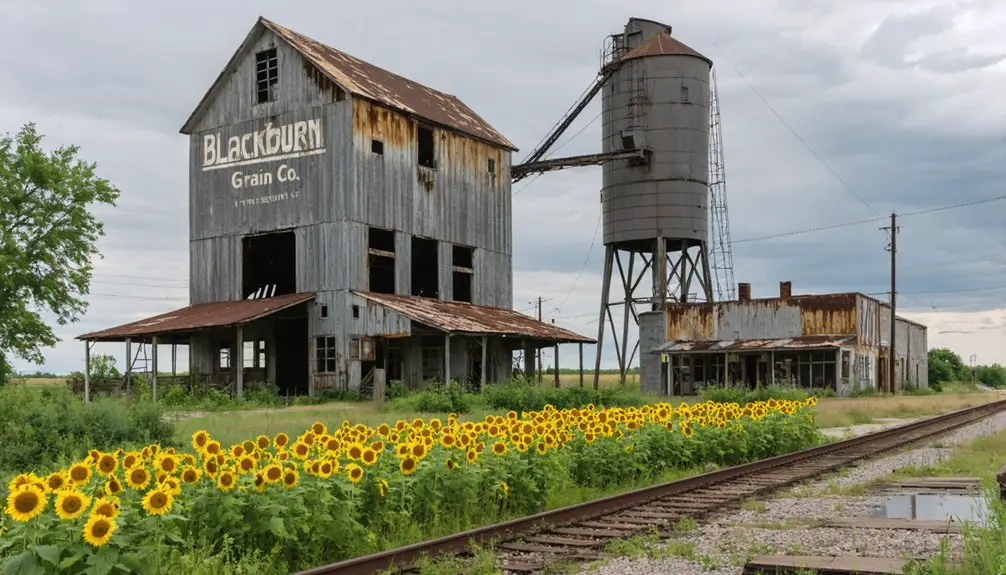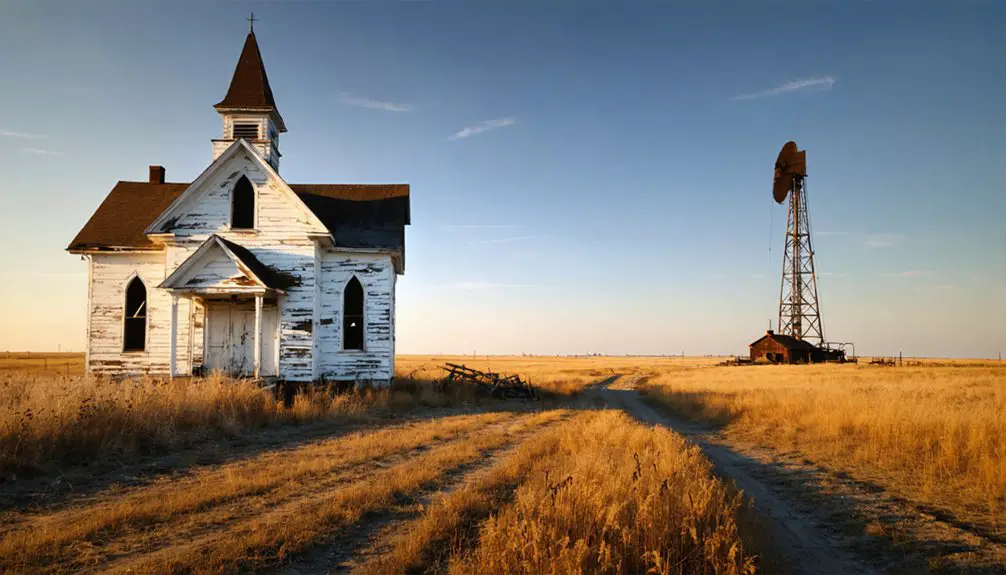You’ll find Blackburn, Oklahoma along the Arkansas River, where it emerged in 1893 as a bustling transportation hub during the Cherokee Outlet land run. The town thrived with cotton gins, flour mills, and a notorious reputation as a “whiskey town” near Indian Territory. Its population peaked at 375 residents in 1930, but drought and farm mechanization led to decline. Today, about 25 families preserve the ghost town’s historic structures and cultural heritage.
Key Takeaways
- Blackburn, Oklahoma peaked at 375 residents in 1930 but declined due to drought and farm mechanization, becoming a ghost town.
- Founded in 1893 near the Arkansas River, the town served as a vital transportation hub with bridges and ferry services.
- The town’s economy was based on agriculture, featuring cotton gins and flour mills, supported by two banks established by 1909.
- Today, approximately 25 families maintain cultural preservation efforts, with several historic structures still standing, including a 1905 schoolhouse.
- The town gained notoriety as a “whiskey town” during territorial days and later became a bootlegging hub after Oklahoma statehood.
The Rise of a River Crossing Settlement
When settlers sought reliable river crossings in Oklahoma Territory during the late 1800s, Blackburn emerged as an indispensable transportation hub along the Arkansas River.
You’d find multiple crossing options at this strategic location, including a toll bridge, wagon bridges, and a ferry service connecting to Osage Nation lands.
The settlement’s growth exploded after the Cherokee Outlet opening in 1893, as you’d witness increasing traffic between Oklahoma Territory and Indian Territory.
Much like the Hooker Bridge in Purcell that was built in 1899, Blackburn’s river crossing facilities proved critical for the region’s development, supporting both agricultural commerce and community expansion.
The town quickly established essential infrastructure, including a cotton gin, flour mill, and blacksmith shops.
You’d see this riverside settlement transform into a bustling community, marked by the establishment of a post office and local newspapers that kept residents connected.
The town’s prosperity continued into the early 1900s, when it hosted the Pawnee County fair from 1903 to 1909.
From Cherokee Outlet to Whiskey Town
You’ll find Blackburn’s origins tied directly to its strategic position on the Arkansas River’s south bank, where a natural ford provided essential access between Oklahoma Territory and the Osage Nation.
The chaotic land run of September 16, 1893, brought waves of settlers seeking their fortunes in the newly opened territory. Over 100,000 pioneers raced to claim available homesteads during this historic event.
After the 1893 Cherokee Outlet opening transformed the area from Cherokee land into settler territory, Blackburn’s location at the territorial boundary created a perfect setup for whiskey trade.
This positioning between Oklahoma Territory and Indian Territory, where alcohol was prohibited, helped establish Blackburn’s notorious reputation as a “whiskey town” until Oklahoma achieved statehood in 1907.
Strategic River Crossing Location
The strategic location of Blackburn, Oklahoma emerged from its position along a natural ford of the Arkansas River, making it an important transportation hub between Oklahoma Territory and the Osage Nation. The river ford’s accessibility allowed wagons to cross easily, establishing crucial trade routes that connected territories on both sides of the Arkansas.
You’ll find that before bridges and ferries were built, this natural crossing point drew settlers, merchants, and travelers. The area became notorious as a whiskey town until Oklahoma achieved statehood in 1907. Like many Oklahoma ghost towns, it emerged to serve alcohol to residents from neighboring dry territories.
Eventually, infrastructure expanded to include a toll bridge and ferry service, strengthening Blackburn’s role as a regional trade center. The town’s position on the border between Oklahoma Territory and Indian Territory’s “dry zone” proved particularly advantageous, as it became a key access point for commerce flowing between these legally distinct regions.
Bootlegging Between Two Territories
Following Oklahoma’s statehood in 1907, Blackburn’s strategic position between territories transformed it into a bustling hub for bootleggers, earning it the nickname “Whiskey Town.”
You’d find sophisticated networks of illegal alcohol distributors exploiting the jurisdictional gaps between Indian Territory and Oklahoma Territory, where differing liquor laws created prime opportunities for underground commerce. Many local sheriffs overlooked the illegal activities to maintain their political support base.
The bootlegging dynamics shaped Blackburn’s identity through:
- Private clubs and hotels serving as fronts for illicit liquor sales
- Violent territorial conflicts between rival bootleggers like Stutsman and Beatty
- Local law enforcement caught between crackdowns and protection rackets
- A thriving underground economy serving all social classes
- The National Bootlegger’s Protective Association’s influence on local operations
These territorial conflicts and widespread demand for stronger alcohol than the legal 3.2% beer kept Blackburn’s bootlegging operations profitable despite prohibition laws. The region’s illegal trade was bolstered by organizations like the National Bootleggers Protective Association, which had amassed over 227,000 members during its peak.
Agricultural Legacy and Economic Life
Since its establishment, Blackburn’s economic foundation rested firmly on agricultural pursuits, with cotton and corn serving as the primary crops that sustained the community’s growth.
You’d find the town’s economic resilience reflected in its robust agricultural infrastructure, including cotton gins and flour mills. Local businesses, from blacksmith shops to livery stables, supported the farming community’s needs. The town gained a reputation as a whiskey town before prohibition took effect.
Despite facing significant challenges, including the devastating drought of 1901 that forced hundreds of farmers to abandon their land, Blackburn’s agricultural innovations continued through farmer associations and annual county fairs.
The town maintained its agricultural identity even as neighboring communities shifted toward oil production. Two banks emerged by 1909, supporting farm loans and local commerce, while the installation of telephone systems by 1912 modernized farm-to-market communications.
Transportation Hub Between Two Territories
While agricultural activities drove Blackburn’s economy, its strategic location along the Arkansas River shaped its identity as a significant transportation nexus.
Blackburn flourished as a vital river crossing, transforming from farming community to crucial transportation hub along the Arkansas River.
You’ll find the town’s transportation evolution reflected in its multiple crossing methods, connecting Oklahoma Territory to the Osage Nation and broader Indian Territory. The area gained prominence as one of the Butterfield stage stations that facilitated mail delivery across the expanding western territories.
- Toll bridges, wagon bridges, and ferries enabled important commerce between territories
- Located at a natural ford 12 miles east of Pawnee, linking major county roads
- Served as a gateway between “dry” Indian Territory and Oklahoma Territory
- Facilitated stagecoach routes, mail delivery, and agricultural trade
- Generated revenue through toll collection and ferry operations
The town’s position fostered economic interactions between settlers and Indigenous populations, while supporting regional mail routes and stage lines that were indispensable for territorial development and cross-border commerce.
Natural Disasters and Population Shifts

As natural forces tested Blackburn’s resilience in the early 1900s, a devastating drought in 1901 marked the beginning of significant demographic changes.
You’ll find that hundreds of farming families abandoned their cotton and corn fields, dealing the first major blow to the town’s agricultural foundation.
While Blackburn’s position near the Arkansas River created flooding risks, you won’t discover any record of major floods or tornados devastating the town.
Instead, the community decline stemmed from the drought impact and gradual economic shifts. The population peaked at 375 residents around 1930, then steadily decreased as farm mechanization reduced labor needs.
Despite the exodus, some residents maintained their connection to Blackburn through social associations and annual reunions well into the mid-20th century.
Community Spirit and Social Gatherings
You’ll find that Blackburn’s vibrant community life centered around annual gatherings like the Pawnee County Fair, which the town proudly hosted from 1903 to 1909.
The town’s three churches, established by 1909, served as spiritual and social anchors that brought residents together regularly for worship and fellowship.
These community institutions fostered strong social bonds among Blackburn’s residents, creating lasting traditions that would help sustain the town’s spirit through challenging times ahead.
Annual County Fair Celebrations
From 1903 to 1909, Blackburn established itself as the proud host of the annual Pawnee County Fair, creating an essential social cornerstone for the region’s scattered farming families.
These agricultural showcases reflected the community’s deep roots in cotton and corn farming while fostering crucial county fair traditions that would shape the town’s identity.
At these vibrant gatherings, you’d experience:
- Competitive livestock shows featuring cattle, swine, sheep, and poultry
- Youth-focused agricultural programs and contests
- Traditional farmhand Olympics showcasing physical skills
- Indoor exhibitions highlighting local talents and crafts
- Horse shows and agricultural technique demonstrations
Even after the fair’s relocation, Blackburn’s community continued hosting reunion events reminiscent of these cherished gatherings well into the 1950s, preserving their legacy of bringing people together through shared agricultural heritage.
Religious Groups Unite Together
Through steadfast cooperation and shared values, Blackburn’s religious institutions formed the bedrock of community life by 1909.
You’ll find that church collaboration extended far beyond Sunday services, as denominations shared facilities and coordinated events that united the town’s families. The Methodist Church, now on the National Register of Historic Places, alongside Baptist missions, created essential gathering spaces for worship and community events.
Even as Blackburn’s population dwindled to about 25 families, these religious groups maintained strong social bonds through potlucks, holiday celebrations, and annual reunions.
They’ve provided significant support during hard times, from the 1901 drought through the Great Depression, organizing food drives and charitable outreach.
The churches’ joint efforts in hosting local governance meetings and educational talks have preserved Blackburn’s community spirit across generations.
Historic Infrastructure and Architecture

The strategic location of Blackburn’s founding near a natural ford of the Arkansas River shaped its early infrastructure development in 1893.
You’ll find the town’s historic buildings reflected both necessity and progress, with architectural styles ranging from practical frontier structures to more substantial civic monuments.
Key infrastructure highlights included:
- A stone schoolhouse built in 1905 using locally quarried sandstone
- Multiple bridges and a ferry system connecting to Osage Nation
- A cotton gin and flour mill serving agricultural needs
- Early telephone system installation by 1912
- Various commercial buildings including a bank, general stores, and blacksmith shops
Blackburn’s infrastructure balanced durability with function, as seen in the surviving schoolhouse and the strategic placement of commercial buildings that supported both local and cross-river trade.
The Osage Nation Connection
Located along the northern boundary of Osage Nation territory, Blackburn played a significant role as a border town between Oklahoma Territory and tribal lands during the late 19th century.
You’ll find that the town’s strategic position made it an important crossing point, with a toll bridge and ferry service facilitating trade across the Arkansas River between settlers and the Osage people.
While Blackburn remained primarily agricultural and gained notoriety as a “whiskey town,” the neighboring Osage Nation demonstrated remarkable resilience through cultural preservation despite forced relocations.
Despite facing displacement, the Osage people maintained their cultural identity while Blackburn evolved into a farming and liquor trade hub.
The stark contrast between Blackburn’s modest development and the Osage Nation’s oil wealth highlights their successful negotiation to retain mineral rights in 1906.
This economic disparity shaped the dynamics between the communities, though they remained connected through shared transportation infrastructure and border commerce.
Modern Day Remnants and Heritage

Despite its ghost town status, modern-day Blackburn retains several significant structures that tell its story of decline, including an abandoned schoolhouse, a defunct gas station, and remnants of its once-bustling business district.
Today, about 25 families maintain cultural preservation efforts and community identity through their role as informal caretakers of the town’s historical sites.
Key elements of modern Blackburn include:
- The preserved school building, which closed in 1968
- A historic gas station from the early 20th century
- Standing church buildings that reflect the town’s religious heritage
- Remnants of the former business district
- Inhabited small homes that keep the community alive
While Blackburn’s population has stabilized around 108 residents, you’ll find its whiskey town legacy and agricultural heritage living on through the dedicated families who preserve its story.
Frequently Asked Questions
Are There Any Famous Outlaws or Lawmen Associated With Blackburn’s History?
You won’t find any famous outlaw legends or lawman tales tied specifically to Blackburn. While illegal whiskey trading occurred, historical records don’t identify notable individuals who shaped the town’s frontier story.
What Native American Artifacts Have Been Discovered in the Blackburn Area?
Like scattered breadcrumbs of time, you’ll find Native artifacts near Blackburn including stone projectile points, pottery shards, hide scrapers, hearth remains, and storage pits buried 18-22 inches deep.
Did Blackburn Have Any Significant Role During the Civil War?
You won’t find any Civil War historical significance in Blackburn since it didn’t exist during the war – the town wasn’t established until 1893, nearly three decades after the conflict ended.
What Happened to the Original Toll Bridge’s Construction Materials?
Like scattered puzzle pieces lost to time, you’ll find the toll bridge materials were likely dismantled and repurposed locally, with steel sold for scrap and wooden components recycled for construction or fuel.
Were There Any Notable Conflicts Between Bootleggers and Law Enforcement?
While you’d expect violent clashes between bootlegging operations and law enforcement tactics in Blackburn, there’s no direct evidence of specific conflicts, though the area was known for whiskey-related lawlessness.
References
- https://en.wikipedia.org/wiki/List_of_ghost_towns_in_Oklahoma
- https://pocketsights.com/tours/place/Blackburn-22581:2749
- https://rhysfunk.com/2017/04/09/a-much-needed-escape/
- https://www.okhistory.org/publications/enc/entry?entry=BL006
- https://abandonedok.com/class/disappearing-town/
- https://www.purcellok.gov/183/History
- https://www.okhistory.org/publications/enc/entry?entry=UN001
- http://blogoklahoma.us/place/45/leflore/butterfield-overland-mail-rout
- https://npshistory.com/publications/buov/coo-v97n1-2019.pdf
- https://www.okhistory.org/publications/enc/entry?entry=CH021



